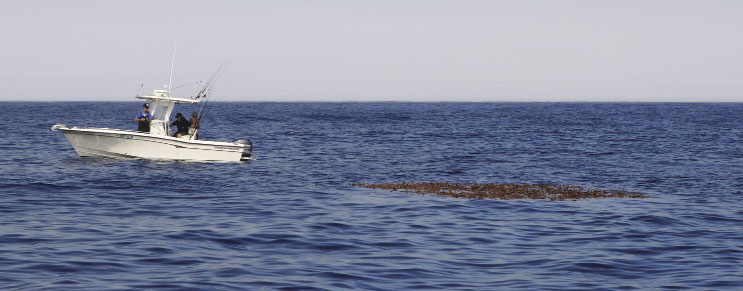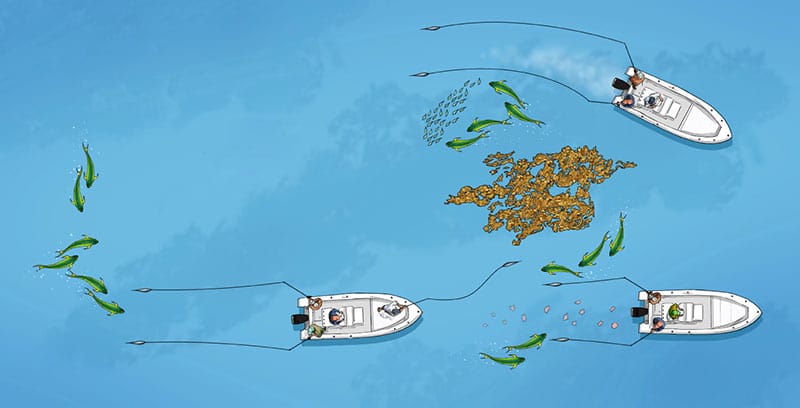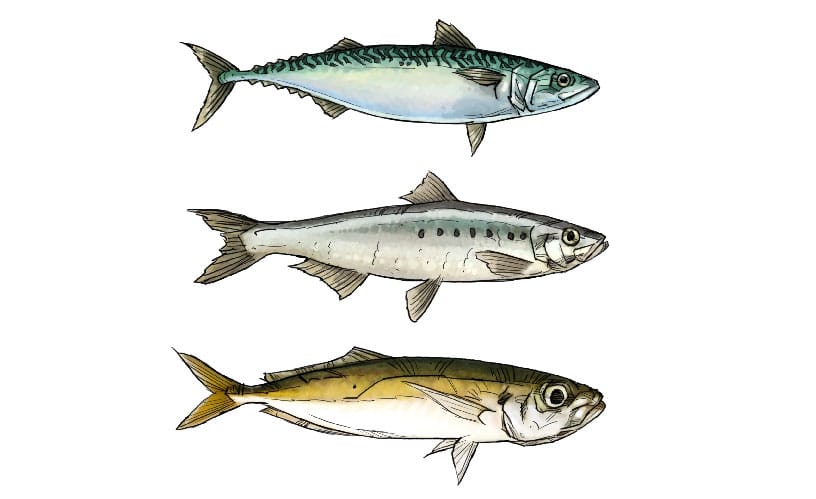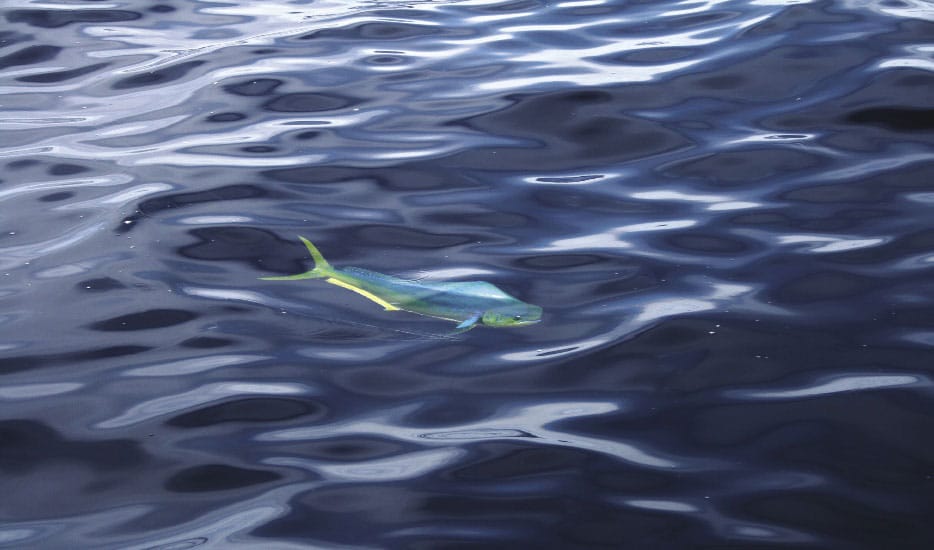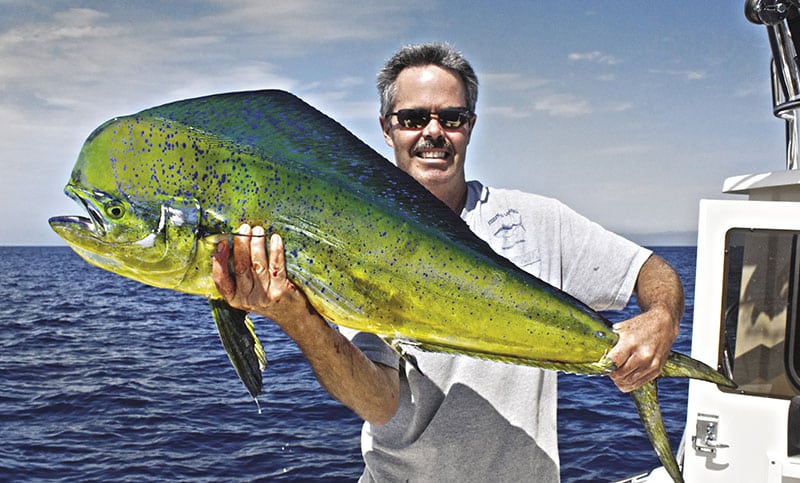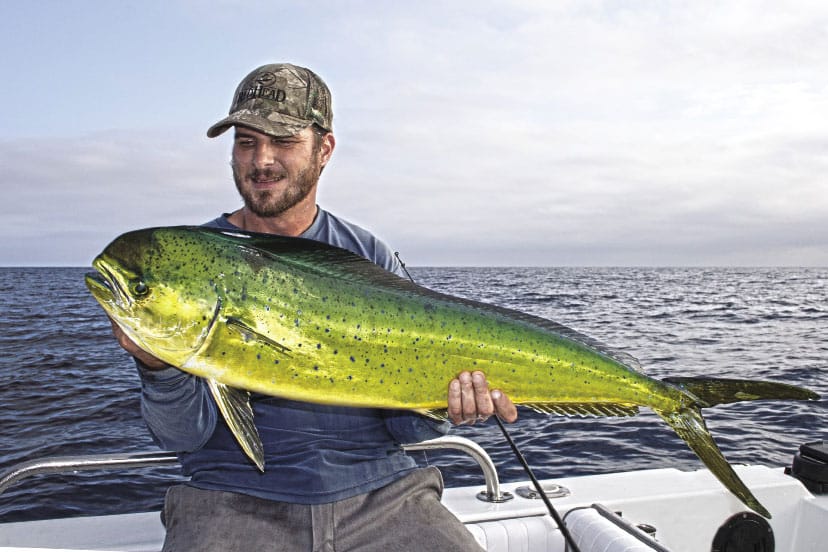
Southern California anglers still rave about last summer when hordes of mahimahi (aka dorado or dolphin) from 12 to 25 pounds migrated up from Mexico and stayed in U.S. waters for weeks. Floating clumps of kelp, known as paddies, swarmed with the mahi, some just a few miles off the beach.
Boats of all sizes from Long Beach, Newport Beach, Dana Point, Oceanside and San Diego pursued the acrobatic and great-tasting mahi in the summer of 2012. By most accounts, that marked the beginning of an El Niño cycle, indicated by higher-than-normal sea temperatures in the northeastern Pacific Ocean, and the appearance of tropical visitors such as the mahi.
However, West Coast mahi can become surprisingly picky when they’re as far north as California. It’s not unusual to find a paddy that’s holding fish, only to discover that the school has virtually no appetite.
But hungry or not, mahi will likely return to Southern California ocean waters this summer, as El Niño cycles span three to four seasons. Here’s how to prepare for their return.
Afternoon Action
Anglers try to be on the fishing grounds as early as possible in the morning, with the idea that the first boat to a kelp paddy stands the best chance. But last season’s experience proved that it’s sometimes better to fish in the afternoon. While fishing can be good around the offshore banks — such as the 43, 181, 182 and 209 — anglers who run out in the dark or gray light of morning miss out on action around the paddies closer to the coast.
Also, you’re often more likely to find mahi under paddies later in the day, as they seem to feed more aggressively in the late afternoon, perhaps because solar heating of the sea surface boosts their metabolism. It’s also easier to find kelp paddies in the afternoon, as they are more visible against the blue ocean once the sun burns through the coastal clouds.
Take It Easy
Search for paddies slowly, cruising at 15 to 18 knots, giving you and your crew a chance to scan the water. Try to get as much elevation as possible: Boats with towers have a distinct advantage.
Paddies range from doormat to garage-door size, with gulls or terns sometimes using them as rest stops. The bigger the paddy, the better; but don’t ignore a patch of floating kelp because it looks insignificant. A few leaves of kelp can attract bait and a school of mahi, especially in the afternoon.
Once you find kelp, slow the boat to idle before you get close. Try to set up a drift by the paddy, and shut off the engine. This prevents scattering the school.
Unlike California yellowtail — which also frequent kelp paddies — mahi don’t always mill in the shadows. You will often find the school on the move, circling as far as 50 yards from the kelp. Start your drift about the same distance from the paddy.
If there’s no wind, slow-troll live baits 50 to 75 feet back as you approach the paddy, and have an angler ready to cast forward to the paddy before the boat reaches it. The idea is to present a live bait to the fish under the weeds before the boat spooks the school.
Another productive technique is to slow-troll live baits in a 75-yard-wide circle around the paddy, particularly if you see free-jumpers leaping clear of the water. This indicates the mahi have driven a school of baitfish away from the paddy and have forced it to the surface. The free-jumpers are pouncing on top of the school as other mahi are pushing the bait upward. Pull baits close to the school by trolling around the feeding fish without driving through them.
Best Baits
Once they get finicky, California mahi seem to shun lures and dead baits. To consistently score, you’ll need live bait.
One of the best go-to baits is the Pacific sardine. These are available at bait barges in harbors along the coast. Pacific mackerel are even better mahi baits, and they are hardier than sardines in the livewell, but you usually have to jig up your own using a sabiki rig. Another hardy and productive bait is the Pacific jack mackerel — known locally as a Spanish mackerel — but as with Pacific mackerel, you need to catch these yourself. You can often jig these species under kelp paddies, particularly those that are not holding any game fish.
Go Light
As you upscale your bait, downscale your tackle. California mahi can become very line shy, so fluorocarbon top shots are a must. Most successful anglers fly-line with nothing heavier than 20-pound-test, but some scale back to 15- or even 12-pound-test.
One of the best ways to hook a sardine or mackerel is through the roof of the mouth and out the top of the nose. This will conceal the hook, allow the bait to breathe and prevent the hook burying itself in the bait.
Once a mahi bites, free-spool for a second or two, then put the reel in gear, point the rod at the fish and wind line as quickly as you can. Don’t wait for the running fish to set the hook. Mahi tend to feel the pressure before you do and spit the bait.
Chunk It
At times, you’ll see mahi That won’t bite. Rather than leave, set up a chunk line. Cut up dead or frozen baits and drop one or two chunks at a time as you drift away from the paddy. Wait for each chunk to disappear before dropping the next one. At the same time, drift two or three lively baits, staggered from 75 to 150 feet behind the boat. Drift for a quarter-mile, and if you don’t get bit, slow-troll up the chum line and repeat the process. Interestingly, most strikes with this tactic come on the slow-troll back to the paddy.
Chunking also pays off when fishing pressure shuts down a bite. In years past, if a skipper found a paddy, other boats steered clear. Today, that code is history, as other boaters zero in when they see someone stopped. Free-divers won’t hesitate to jump in to spear mahi while you’re fishing for them either. It’s not unusual to find 10 or more boats on a single paddy, especially one that’s close to the coast.
In these situations, mahi usually shy away from the paddy where the boats are hovering. By drifting away and chunking, you might draw the fish to you. If you hook up, delay landing the dorado until you can hook another one. This holds the school close by. At the same time, maintain a chunk line and toss out one or two live baits to keep the mahi in the mood to bite.
If the dorado swim north into U.S. waters again this summer, angling pressure off Southern California will no doubt intensify. Adopt new tactics and refine your tackle to catch these beautiful visitors amid the mahi madness.
SWS Tackle Box
Two elements contribute to a bait’s effectiveness for California mahi. The first is vitality. The bait needs to be hot, fast and frisky when it hits the water. The other key element is size. Baits of four inches or less don’t seem to interest California mahi, so avoid tanking up with anchovies or small sardines. The bait needs to be at least five to eight inches in length, whether mackerel or sardines. At times, even larger baits, such as a foot-long Pacific mackerel, will trigger a bite.
Baits and Rigs: Fly-lined live sardines or mackerel, five to eight inches long
Rods: 7- to 8-foot light-action rods
Reels: Small, fast star-drag reels such as the Daiwa Saltist 20H
Line: 12- to 20-pound-test fluorocarbon top shot with 20-pound monofilament main line
Terminal Rig: Single 3/0 Owner Mutu Light Circle Hook; for large mackerel, use 4/0 or 5/0 circle hooks. Tie the hook directly to the fluoro top shot.
SWS Planner
What: Mahimahi (aka dorado, dolphin)
Where: Coastal and offshore waters from Long Beach to San Diego, around kelp paddies
When: July through early October; July and October are good; August through September is excellent.
Who: Boating anglers with reliable craft from 20 feet and up. Here are three top captains who can show you how it’s done:
Capt. Barry Brightenburg
Always an Adventure Charters
619-540-8944
alwaysanadventurecharters.com
Capt. Brandon Hayward
One Man Charters
949-212-0719
onemancharters.com
Capt. Dave Hanson
Your Saltwater Guide
949-374-0786
yoursaltwaterguide.com

